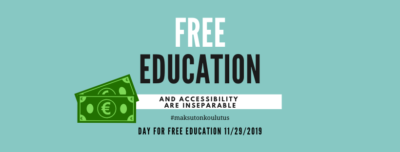Higher education is still not accessible to everyone on the equal basis. There is a limited number of study places in the universities and universities of applied sciences, which means that not everyone who wants to study gets a place. Transition from the secondary education to the higher education might be delayed due to various reasons, and a young person might need to have gap years before starting the studies. Moreover, Finland introduced tuition fees for the students coming outside the EU and EEA in 2017. This means that education is not truly free anymore in Finland.
Apart from a few exceptions, there has not been much public debate about the accessibility of Finnish higher education. According to the common understanding, equality in education means that the income level or family background should not prevent anybody from studying. However, the study by Hanna Nori (2011) indicates that the selection of students favour young applicants who live in the cities and whose parents have higher education. According to OECD gender also affects the studies, as women are more likely to complete their studies in target time than men.
The government programme of Prime Minister Rinne’s cabinet includes the objective to increase the level of education and competence among the population, to decrease differences in learning outcomes as well as to increase educational equality. The government will create an accessibility plan to higher education in order to identify factors that hinder equality during the transition periods and studies. Another goal is to support the access to education and completion of degrees for underrepresented population groups with the help of set indicators and actions.

Free education in Finland has guaranteed that studies in higher education have been possible for everyone regardless of the economic background. The education, occupational status or wealth of the parents have not influenced if higher education is regarded as worthwhile or not. According to the OECD, parents’ educational background plays a smaller role in the completion of studies in Finland than in other countries. On the other hand, students with lower socio-economic backgrounds consider taking student loan and working during the studies necessary.
“For me the costs related to education became real already during the secondary education. Sometimes I even needed to choose between food or study materials. At the moment when I turned 18, I took a study loan because there was no other means to support myself. I feel that the increasing loan is a heavy burden to carry. Now in the university I feel the pressure to graduate as fast as possible because the amount of loan is accumulating”, says Jenna Rantanen, the educational affairs organiser in TREY’s executive board.
The education is not truly free if nothing is done to promote educational equality and accessibility. We must invest in each student’s capacity to study full time in order to prevent further inequality. In order not to lose the basis for the work towards accessibility, the principle of free education must be preserved.
Free education is the key in supporting access to education.
*Friday 29 November is the National Day of Free Education organised by the National Union of University Students in Finland and student unions. #maksutonkoulutus #studentsoffinland